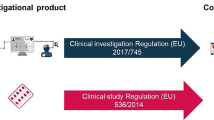Abstract
Background
Drug approval lag is the time difference for new medicine to obtain marketing authorization approval in the study country compared to the first global approval. Drug approval lag delays the availability of innovative medicine to patients. This may lead to delay in treatment and severe public health implications. The study aimed to determine drug approval lag in Malaysia, the factors associated with drug approval lag (drug characteristics, regulatory factors and applicant type) and the association of the submission lag and review time with the regulation change.
Methods
All new pharmaceutical products approved between January 2015 and March 2021 were examined (n = 136) using publicly available information. Factors associated with drug approval lag were determined using multiple linear regression.
Results
The median drug approval lag was 855 days. Drug approval lag was associated with drug characteristics and regulatory factors. Median submission lag and median review time for products which fulfilled the requirement for the new regulations (Conditional Registration/ Facilitated Registration Pathway) were shorter compared to products which did not fulfil the requirement.
Conclusion
Drug approval lag may delay the access of innovative medicine to patients, and this may lead to an increase in morbidity, mortality and healthcare costs. Good Regulatory Practices ensure efficient and transparent regulatory system which support the public health policy objectives in the most efficient way. The new regulations in Malaysia reduced the median submission lag and review time. The findings may be useful for regulators to consider for future policy development for medication access.




Similar content being viewed by others
References
Tamimi NA, Ellis P. Drug development: from concept to marketing! Nephron Clin Pract. 2009;113(3):c125–31.
Gispen-de Wied CC, Leufkens HGM. From molecule to market access: drug regulatory science as an upcoming discipline. Eur J Pharmacol. 2013;719(1):9–15.
Sani NM, McAuslane N, Kasbon SH, Ahmad R, Yusof FAM, Patel P. An evaluation of Malaysian regulatory process for new active substances approved in 2017 using the OpERA methodology. Ther Innov Regul Sci. 2020;54:1215–24.
Nakayama H, Matsumaru N, Tsukamoto K. The drug lag and associated factors for orphan anticancer drugs in Japan compared to the United States. Invest New Drugs. 2019;37(5):1086–93.
Wileman H, Mishra A. Drug lag and key regulatory barriers in the emerging markets. Perspect Clin Res. 2010;1(2):51.
Rodriguez CA, Brooks MB, Guglielmetti L, Hewison C, Jachym MF, Lessem E, et al. Barriers and facilitators to early access of bedaquiline and delamanid for MDR-TB: a mixed-methods study. Public Health Action. 2019;9(1):32–41.
Guideline on Facilitated Registration Pathway: Abbreviated and Verification Reviews [updated March 2019; cited 2020 Dec 1]. https://www.npra.gov.my/easyarticles/images/users/1048/gambar/DirektifBil7_2019.pdf.
Guidelines on Conditional Registration for New Chemical Entities and Biologics in Malaysia 2020. 2nd ed. [updated 28 September; cited 2020 Dec 15]. https://www.npra.gov.my/easyarticles/images/users/1047/GUIDELINES-ON-CONDITIONAL-REGISTRATION-FOR-NEW-CHEMICAL-ENTITIES-AND-BIOLOGICS-IN-MALAYSIA-2nd-edition---Dec-2020.pdf.
Patel P, McAuslane N, Liberti L. Trends in the Regulatory Landscape for the Approval of New Medicines in Asia. London: Centre for Innovation in Regulatory Science; 2019.
Frieder J, Kivelevitch D, Fiore CT, Saad S, Menter A. The impact of biologic agents on health-related quality of life outcomes in patients with psoriasis. Expert Rev Clin Immunol. 2018;14(1):1–19.
Callhoff J, Weiß A, Zink A, Listing J. Impact of biologic therapy on functional status in patients with rheumatoid arthritis—a meta-analysis. Rheumatology. 2013;52(12):2127–35.
Yuan M, Huang L-L, Chen J-H, Wu J, Xu Q. The emerging treatment landscape of targeted therapy in non-small-cell lung cancer. Signal Transduct Target Ther. 2019;4(1):61.
Baird L, Banken R, Eichler HG, Kristensen F, Lee D, Lim J, et al. Accelerated access to innovative medicines for patients in need. Clin Pharmacol Ther. 2014;96(5):559–71.
Sun I-C. Significant differences on submission lag following regulation reform for registration of novel therapeutic drugs in Taiwan. Invest New Drugs. 2019;37(5):1094–106.
Lee S-W, Park S-H, Song I, Noh Y, Park H, Ha D, et al. Notable differences in drug lag between Korea and Japan of new drugs between 2009 and 2017. Ther Innov Regul Sci. 2020;54(2):418–23.
Funding
The authors declared no financial support of the research, authorship and/or publication of this article.
Author information
Authors and Affiliations
Contributions
CWL contributed to the data collection, data analysis and manuscript preparation; NAMS contributed to the concept and manuscript review; KTS contributed to the concept, manuscript review and accountable for the correspondence related to the manuscript.
Corresponding author
Ethics declarations
Conflict of interest
The authors declared no potential conflicts of interest with respect to the research, authorship and/or publication of this article.
Additional information
Publisher's Note
Springer Nature remains neutral with regard to jurisdictional claims in published maps and institutional affiliations.
Rights and permissions
Springer Nature or its licensor (e.g. a society or other partner) holds exclusive rights to this article under a publishing agreement with the author(s) or other rightsholder(s); author self-archiving of the accepted manuscript version of this article is solely governed by the terms of such publishing agreement and applicable law.
About this article
Cite this article
Chow, W.L., Salleh, N.A.M. & Kang, T.S. Access to Innovative Medicines: Regulation Change and Factors Associated with Drug Approval Lag in Malaysia. Ther Innov Regul Sci 58, 528–538 (2024). https://doi.org/10.1007/s43441-024-00620-x
Received:
Accepted:
Published:
Issue Date:
DOI: https://doi.org/10.1007/s43441-024-00620-x




